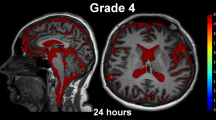Abstract
Purpose
Abnormal cerebrospinal fluid (CSF) dynamics can produce a number of significant clinical problems to include hydrocephalus, loculated areas within the ventricles or subarachnoid spaces as well as impairment of normal CSF movement between the cranial and spinal compartments that can result in a cerebellar ectopia and hydrosyringomyelia. Thus, assessing the patency of fluid flow between adjacent CSF compartments non-invasively by magnetic resonance imaging (MRI) has definite clinical value. Our objective was to demonstrate that a novel tag-based CSF imaging methodology offers improved contrast when compared with a commercially available application.
Methods
In a prospective study, ten normal healthy adult subjects were examined on 3T magnets with time-spatial labeling inversion pulse (Time-SLIP) and a new tag-based flow technique—time static tagging and mono-contrast preservation (Time-STAMP). The image contrast was calculated for dark-untagged CSF and bright-flowing CSF. We tested the results with the D’Agostino and Pearson normality test and Friedman’s test with Dunn’s multiple comparison correction for significance. Separately 96 pediatric patients were evaluated using the Time-STAMP method.
Results
In healthy adults, contrasts were consistently higher with Time-STAMP than Time-SLIP (p < 0.0001, in all ROI comparisons). The contrast between untagged CSF and flowing tagged CSF improved by 15 to 34%. In both healthy adults and pediatric patients, CSF flow between adjacent fluid compartments was demonstrated.
Conclusions
Time-STAMP provided images with higher contrast than Time-SLIP, without diminishing the ability to visualize qualitative CSF movement and between adjacent fluid compartments.




Similar content being viewed by others
References
Bradley WG, Kortman KE, Burgoyne B (1986) Flowing cerebrospinal fluid in normal and hydrocephalic states: appearance on MR images. Radiology 159:611–616
Bradley WG, Whittemore AR, Kortman KE, Watanabe AS, Homyak M, Teresi LM et al (1991) Marked cerebrospinal fluid void: indicator of successful shunt in patients with suspected normal-pressure hydrocephalus. Radiology 178:459–466
Sharma AK, Gaikwad S, Gupta V, Garg A, Mishra NK (2008) Measurement of peak CSF flow velocity at cerebral aqueduct, before and after lumbar CSF drainage, by use of phase-contrast MRI: utility in the management of idiopathic normal pressure hydrocephalus. Clin Neurol Neurosurg 110:363–368
Yamada S, Tsuchiya K, Bradley WG, Law M, Winkler ML, Borzage MT et al (2014) Current and emerging MR imaging techniques for the diagnosis and management of CSF flow disorders: a review of phase-contrast and time-spatial labeling inversion pulse. Am J Neuroradiol 36(4):623–30. https://doi.org/10.3174/ajnr.A4030
Yamada S, Miyazaki M, Kanazawa H, Higashi M, Morohoshi Y, Bluml S, McComb JG (2008) Visualization of cerebrospinal fluid movement with spin labeling at MR imaging: preliminary results in normal and pathophysiologic conditions. Radiology 249:644–652
Acknowledgments
This manuscript is published in memoriam of William G. Bradley: a distinguished clinician and researcher. We would also like to thank JF and DB at Canon Medical Systems USA for their help recruiting volunteers and providing imaging time.
Funding
This work was made possible by the financial support of the Rudi Schulte Research Institute.
Author information
Authors and Affiliations
Corresponding author
Ethics declarations
Conflict of interest
The authors declare that they have no conflict of interest.
Electronic supplementary material
Left: dynamic images for Time-SLIP in a healthy adult subject. The poor contrast in the third ventricle makes it more difficult to observe the flow that may be present. Right: dynamic images for Time-STAMP in a healthy adult subject. The omission of cardiac synchronization did not impair the ability to observe flow patterns, but the use of a static delay time improved the contrast. Improvements to contrast make it easier to observe flow (MP4 3429 kb)
Dynamic images for Time-STAMP in the same 16-year-old shown in Fig. 4. Flow from the fourth ventricle through the patent aqueduct of Sylvius to the 3rd ventricle, as well as flow at the craniocervical junction and prepontine cisterns indicate ETV is likely to be successful (A). Post ETV shows good communication of the fourth ventricle, aqueduct of Sylvius, and third ventricle within the prepontine cisterns (B). Post ETV shows no communication of the outlet of the fourth ventricle, and the presence of turbulent flow within the fourth ventricle (C) (M4V 147 kb)
Rights and permissions
About this article
Cite this article
Borzage, M., Ponrartana, S., Tamrazi, B. et al. A new MRI tag-based method to non-invasively visualize cerebrospinal fluid flow. Childs Nerv Syst 34, 1677–1682 (2018). https://doi.org/10.1007/s00381-018-3845-3
Received:
Accepted:
Published:
Issue Date:
DOI: https://doi.org/10.1007/s00381-018-3845-3




